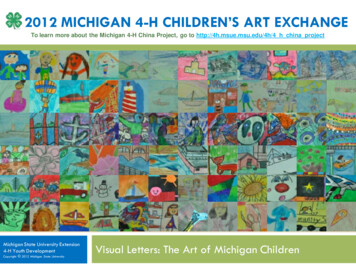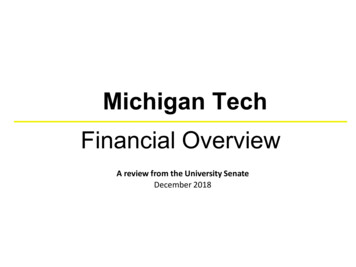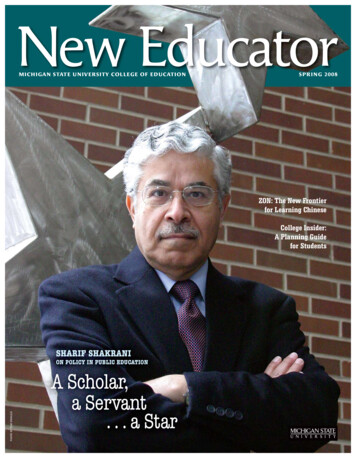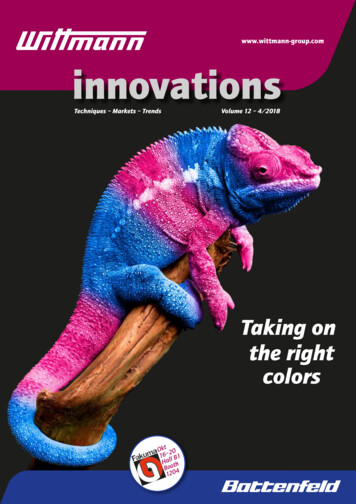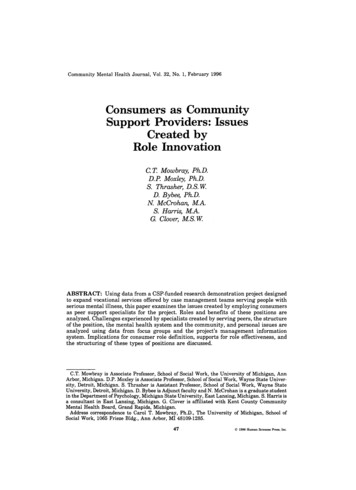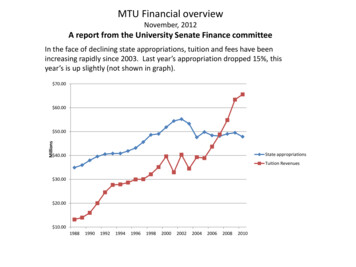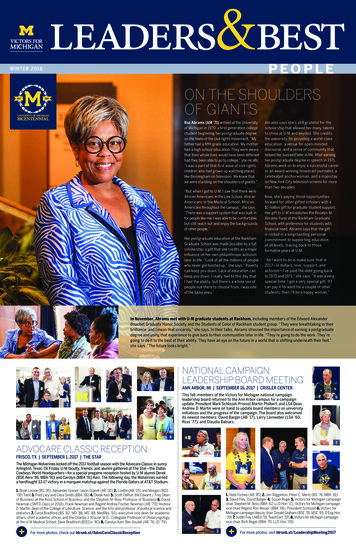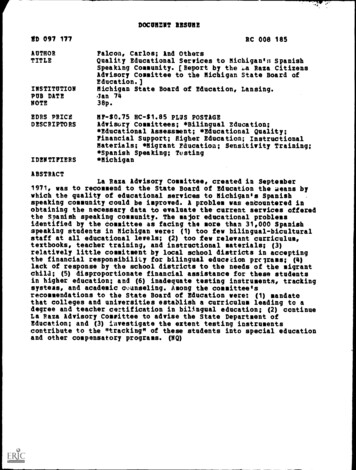
Transcription
2010 2011 B u l l e t i nI ntroduct ion2010-2011 University of MichiganCollege of Engineering BulletinThe online Bulletin reflects the most up-to-date information available and is updated as changesare made to the curriculum. To view past versions of the College Bulletin in Adobe Acrobat format,please visit our archives. Note: Archived bulletins are only applicable to that academic year’s courserequirements. Please visit your advisor for more information, or if you have questions regarding this.Students follow the rules of the College of Engineering Bulletin in effect for the academic term inwhich they begin their studies in the College of Engineering at the University of Michigan-AnnArbor campus. Students who are readmitted into the College of Engineering at the University ofMichigan-Ann Arbor campus follow the Bulletin in effect for the academic term in which theyresume their studies.The College of Engineering Bulletin reflects yearly curricular changes in the various degree programs. A student in a degree program that has degree requirement changes in a Bulletin producedduring their academic career at the College of Engineering at the University of Michigan-AnnArbor, may follow a subsequent Bulletin. This determination should be made in conjunction withthe Program Advisor.For students excited about the potential of technology, there’sno better place to learn and explore than the University ofMichigan College of Engineering. Michigan Engineeringoffers a rare combination of high-quality engineering scholarship, a broad scope of college and university opportunities,and large-scale impact.Michigan Engineers--at the graduate and undergraduatelevels--learn how to apply the latest developments in technological thinking to the world’s major problems. Studentslearn about and participate in pioneering research in a varietyof disciplines, including nanotechnology and integratedmicrosystems, cellular and molecular biotechnology, and information technology. With 11 departments, interdisciplinaryand international programs, more than a dozen student teamprojects and nearly 80 liberal arts minors to choose from, theOffice of Student AffairsChrysler Center143 Chrysler CenterAnn Arbor, Michigan, 48109-2092College offers future engineers an unparalleled range of opportunities. As a result, students leave Michigan prepared forleadership roles in traditional engineering functions as well asin business, medicine, law and teaching.The College’s faculty is composed of scholars who are amongthe best in their fields, including 60 National Science Foundation Career Award recipients and 21 current or emeritusfaculty members of the National Academy of Engineering.Faculty research possibilities are expanded by the University’s 19 schools and colleges. Interdisciplinary research is ahallmark of Michigan Engineering, particularly between theCollege and the schools of Medicine, Business and Information. (Michigan is one of only three universities in the nationwith top-ranked engineering, medical and business schools.)This research and other research within the College makea practical difference in society. The College’s TechnologyTransfer Office works closely with faculty to put research intothe hands of people.Office of Recruitment and AdmissionsRobert H. Lurie Engineering Center1221 Beal AvenueAnn Arbor, Michigan 48109-2102(734) 647-7101(734) 647-7126 n CollegeofEngineering1
C red itsCollege of Engineering BulletinPublication CreditsThe University of Michigan College of Engineering2010-2011June 1, 2010Production CreditsCollege of EngineeringJeanne Murabito, Executive Director for Student Affairs, EditorElizabeth Cammarata, Senior Secretary, Managing EditorJennifer Wegner, Student Affairs Program Manager,Managing EditorNathan Bennett, Editorial StaffThomas Knox, Web ServicesNicole Heffernan, Web ServicesDesignCollege of EngineeringCommunications and MarketingByron Roberts, Senior DirectorDan Kim, DirectorMira Lancaster, Senior Graphic DesignerRuth Pulker, Graphic ArtistCollege of Engineering BulletinThe University of MichiganMary Sue Coleman, PresidentTeresa A. Sullivan, Provost and Executive Vice Presidentfor Academic AffairsOra Hirsch Pescovitz, Executive Vice President for Medical AffairsSally J. Churchill, Vice President and Secretary of the UniversityStephen R. Forrest , Vice President for ResearchE. Royster Harper, Vice President for Student AffairsDavid R. Lampe, Vice President for CommunicationsDaniel Little, Chancellor, University of Michigan - DearbornJerry A. May, Vice President for DevelopmentRuth Person, Chancellor, University of Michigan - FlintSuellyn Scarnecchia, Vice President and General CounselTimothy P. Slottow, Executive Vice President and ChiefFinancial OfficerCynthia H. Wilbanks, Vice President for Government RelationsCollege of EngineeringDavid C. Munson, Jr.,Robert J. Vlasic Dean of EngineeringProfessor of Electrical Engineering and Computer ScienceErdogan Gulari, Associate Dean forResearch and Graduate EducationJames P. Holloway, Associate Dean forUndergraduate EducationS. Jack Hu, Associate Dean for Academic AffairsThomas Zurbuchen, Associate Dean forEntrepreneurial Programs22010 2011 BulletinStudent Affairs & ServicesMercedes Barcia, Director of Engineering Advising CenterKerri Boivin, Director of Engineering Career Resource CenterAmy Conger, Director of International Programs in EngineeringCinda-Sue Davis, Director ofthe Women in Science and Engineering ProgramMike Nazareth, Associate Director for Graduate EducationDerrick Scott, Director ofMulticultural Engineering Programs OfficeDebbie Taylor, Director ofWomen in Engineering Program OfficePete Washabaugh, Director ofWilson Student Team Project CenterKatrina Williams, Director of Recruitment and AdmissionsThe Regents of the University of MichiganJulia Donovan Darlow, Ann ArborLaurence B. Deitch, Bingham FarmsDenise Ilitch, Bingham FarmsOlivia P. Maynard, GoodrichAndrea Fischer Newman, Ann ArborAndrew C. Richner, Grosse Pointe ParkS. Martin Taylor, Grosse Pointe FarmsKatherine E. White, Ann ArborMary Sue Coleman (ex officio)The information contained in this Bulletin is subject tochange at any time. It is intended to serve only as a generalsource of information about the College of Engineering and isin no way intended to state contractual terms.The University of Michigan, as an equal opportunity/affirmative action employer, complies with all applicable federaland state laws regarding nondiscrimination and affirmativeaction, including Title IX of the Education Amendments of1972 and Section 504 of the Rehabilitation Act of 1973. TheUniversity of Michigan is committed to a policy of nondiscrimination and equal opportunity for all persons regardlessof race, sex, color, religion, creed, national origin or ancestry, age, marital status, sexual orientation, gender identity,gender expression, disability, or Vietnam-era veteran status inemployment, educational programs and activities, and admissions. Inquiries or complaints may be addressed to the SeniorDirector for Institutional Equity and Title IX/Section 504Coordinator, Office for Institutional Equity, 2072 Administrative Services Building, Ann Arbor, Michigan 48109-1432,734-763-0235, TTY 734-647-1388. For other University ofMichigan information call 734-764-1817.UniversityofMichigan CollegeofEngineering
2010 2011 B u l l e t i nTab l e of C ontentsTable of ContentsIntroduction. . . . . . . . . . . . . . . . . . . . . . . . . . . . . . . . . . . . . . . . . . . . . . . . . . . . . . . . . . . . . . . . . . . . . . . . . . . . 1Credits. . . . . . . . . . . . . . . . . . . . . . . . . . . . . . . . . . . . . . . . . . . . . . . . . . . . . . . . . . . . . . . . . . . . . . . . . . . . . . . . 2Welcome . . . . . . . . . . . . . . . . . . . . . . . . . . . . . . . . . . . . . . . . . . . . . . . . . . . . . . . . . . . . . . . . . . . . . . . . . . . . . . 4General Information . . . . . . . . . . . . . . . . . . . . . . . . . . . . . . . . . . . . . . . . . . . . . . . . . . . . . . . . . . . . . . . . . . . . . 7Undergaduate Admissions . . . . . . . . . . . . . . . . . . . . . . . . . . . . . . . . . . . . . . . . . . . . . . . . . . . . . . . . . . . . . . . . 11Residency Classification Guidelines. . . . . . . . . . . . . . . . . . . . . . . . . . . . . . . . . . . . . . . . . . . . . . . . . . . . . . . . . 18Financial Aid. . . . . . . . . . . . . . . . . . . . . . . . . . . . . . . . . . . . . . . . . . . . . . . . . . . . . . . . . . . . . . . . . . . . . . . . . . 19Student Life. . . . . . . . . . . . . . . . . . . . . . . . . . . . . . . . . . . . . . . . . . . . . . . . . . . . . . . . . . . . . . . . . . . . . . . . . . . 22Academic Rules . . . . . . . . . . . . . . . . . . . . . . . . . . . . . . . . . . . . . . . . . . . . . . . . . . . . . . . . . . . . . . . . . . . . . . . . 32Undergraduate Education . . . . . . . . . . . . . . . . . . . . . . . . . . . . . . . . . . . . . . . . . . . . . . . . . . . . . . . . . . . . . . . . 47Graduate Education . . . . . . . . . . . . . . . . . . . . . . . . . . . . . . . . . . . . . . . . . . . . . . . . . . . . . . . . . . . . . . . . . . . . 65Aerospace Engineering. . . . . . . . . . . . . . . . . . . . . . . . . . . . . . . . . . . . . . . . . . . . . . . . . . . . . . . . . . . . . . . . . . . 68Atmospheric, Oceanic and Space Sciences . . . . . . . . . . . . . . . . . . . . . . . . . . . . . . . . . . . . . . . . . . . . . . . . . . . . 83Biomedical Engineering. . . . . . . . . . . . . . . . . . . . . . . . . . . . . . . . . . . . . . . . . . . . . . . . . . . . . . . . . . . . . . . . . . 99Chemical Engineering . . . . . . . . . . . . . . . . . . . . . . . . . . . . . . . . . . . . . . . . . . . . . . . . . . . . . . . . . . . . . . . . . . 113Civil and Environmental Engineering . . . . . . . . . . . . . . . . . . . . . . . . . . . . . . . . . . . . . . . . . . . . . . . . . . . . . . 126Electrical Engineering, Computer Engineering and Computer Science . . . . . . . . . . . . . . . . . . . . . . . . . . . . . 145Engineering Physics. . . . . . . . . . . . . . . . . . . . . . . . . . . . . . . . . . . . . . . . . . . . . . . . . . . . . . . . . . . . . . . . . . . . 177Industrial and Operations Engineering. . . . . . . . . . . . . . . . . . . . . . . . . . . . . . . . . . . . . . . . . . . . . . . . . . . . . . 180Interdisciplinary Degree Programs. . . . . . . . . . . . . . . . . . . . . . . . . . . . . . . . . . . . . . . . . . . . . . . . . . . . . . . . . 196Materials Science and Engineering. . . . . . . . . . . . . . . . . . . . . . . . . . . . . . . . . . . . . . . . . . . . . . . . . . . . . . . . . 201Mechanical Engineering. . . . . . . . . . . . . . . . . . . . . . . . . . . . . . . . . . . . . . . . . . . . . . . . . . . . . . . . . . . . . . . . . 213Naval Architecture and Marine Engineering. . . . . . . . . . . . . . . . . . . . . . . . . . . . . . . . . . . . . . . . . . . . . . . . . . 233Nuclear Engineering and Radiological Sciences . . . . . . . . . . . . . . . . . . . . . . . . . . . . . . . . . . . . . . . . . . . . . . . 248Engineering Division Courses . . . . . . . . . . . . . . . . . . . . . . . . . . . . . . . . . . . . . . . . . . . . . . . . . . . . . . . . . . . . 261Environmental Sciences and Engineering. . . . . . . . . . . . . . . . . . . . . . . . . . . . . . . . . . . . . . . . . . . . . . . . . . . . 264Study Abroad. . . . . . . . . . . . . . . . . . . . . . . . . . . . . . . . . . . . . . . . . . . . . . . . . . . . . . . . . . . . . . . . . . . . . . . . . 267Technical Communication. . . . . . . . . . . . . . . . . . . . . . . . . . . . . . . . . . . . . . . . . . . . . . . . . . . . . . . . . . . . . . . 268Applied Physics . . . . . . . . . . . . . . . . . . . . . . . . . . . . . . . . . . . . . . . . . . . . . . . . . . . . . . . . . . . . . . . . . . . . . . . 270Concentrations in Environmental Sustainability. . . . . . . . . . . . . . . . . . . . . . . . . . . . . . . . . . . . . . . . . . . . . . . 273Interdisciplinary Professional Programs . . . . . . . . . . . . . . . . . . . . . . . . . . . . . . . . . . . . . . . . . . . . . . . . . . . . . 274Macromolecular Science and Engineering . . . . . . . . . . . . . . . . . . . . . . . . . . . . . . . . . . . . . . . . . . . . . . . . . . . 291Military Officer Education Program. . . . . . . . . . . . . . . . . . . . . . . . . . . . . . . . . . . . . . . . . . . . . . . . . . . . . . . . 295Academic Calendar . . . . . . . . . . . . . . . . . . . . . . . . . . . . . . . . . . . . . . . . . . . . . . . . . . . . . . . . . . . . . . . . . . . . 300Office Directory. . . . . . . . . . . . . . . . . . . . . . . . . . . . . . . . . . . . . . . . . . . . . . . . . . . . . . . . . . . . . . . . . . . . . . . 303Index. . . . . . . . . . . . . . . . . . . . . . . . . . . . . . . . . . . . . . . . . . . . . . . . . . . . . . . . . . . . . . . . . . . . . . . . . . . . . . . 305UniversityofMichigan CollegeofEngineering3
welcome2010 2011 BulletinWelcome to the University of Michigan!We are a University rich in history, academic excellence and leadership. Theheart of Michigan’s success resides in our dedicated staff, robust student bodyand outstanding faculty members, including distinguished composers, novelists and poets, scientists, engineers, physicians, social scientists, artists, andfilmmakers. The quality, breadth, and depth of this University’s intellectualresources create a remarkable community of scholars -- from our nationalleaders in the social sciences, medicine, engineering, law, and business to ourcommunity’s robust cultural offerings. This is the Michigan Difference!I am particularly enthusiastic about our campus-wide work in the life sciences, including the Life Sciences Institute, the Michigan NanotechnologyInstitute for Medicine and the Biological Sciences, the A. Alfred TaubmanMedical Research Institute Consortium for Stem Cell Therapies, our crossdisciplinary research programs, and our premier U-M Health System. As inso many fields, the benefits of Michigan’s work in health care and life sciencesresearch are felt across the state and around the world – fulfilling the missionand role of a great public university dedicated to advancing the public good.That social contract includes a deep commitment to help strengthen anddiversify our region’s economy. We are contributing in myriad ways: withthe movement of our inventions and technologies to the marketplace, thecreations of entrepreneurial students and faculty, and the development of theNorth Campus Research Complex, where we are eager to build public-privatepartnerships.Ours is a campus of remarkably wide-ranging experiences, cultures andopportunities. This academic year we celebrate the sesquicentennial of theprestigious U-M Law School, as well as the 150th anniversary of the Men’sGlee Club. We will open the doors of an expanded Kelsey Museum ofArchaeology and a renovated Stockwell Hall. And work continues on theconstruction of our two most ambitious projects, C.S. Mott Children’s andWomen’s Hospital and North Quad residential facility.The University of Michigan family shares a deep tradition. It is a traditionknown to the new students who walk into their first class, to the professorswho counsel their graduate students, and to our dedicated alumni around theworld. We are called upon to be leaders, and we respond enthusiastically withnew ideas and actions that help shape our nation and world.Sincerely,Mary Sue ColemanPresidentUniversity of Michigan4UniversityofMichigan CollegeofEngineering
2010 2011 B u l l e t i nwelcomeWelcome!Hello, I’m Dave Munson. As dean of the University of Michigan Collegeof Engineering, I can assure you, if you’re interested in exploring and applyingtechnology, you’ve come to the right place. With a rare combination of topscholars, an international footprint and multidisciplinary opportunities, Michigan Engineering is a global leader in engineering education and research.Here you’ll learn to think logically, deal with uncertainty and change, work withtechnology in a socially and environmentally responsible manner, communicateeffectively and collaborate with other bright students, all within a supportivecommunity. Your student experience will be enhanced by an alumni network of65,000 worldwide. For example, alumni and corporate support was instrumental to the success of our Progress and Promise: 150th Anniversary Campaign,which provided 300 million of new resources for Michigan Engineering scholarships, professorships and facilities. You’ll be able to explore 12 highly rankedacademic departments and nearly 100 student teams and organizations(including the only five-time solar car national champion!)If you’re enrolling as a graduate student, you probably know that the Universityof Michigan is one of the nation’s premier research universities. Interacting withworld-renowned scholars, you may work on solutions that make an impact atthe nanoscale or the cosmic scale. The University generates 1 billion of researcheach year, 160 million of which is produced by the College of Engineering.This research spans all engineering disciplines.Students pursuing engineering careers can look forward to promising futures. If you’re seeking a career in medicine, law or business,you’ll find a degree in engineering is an excellent foundation. Meanwhile, you can take advantage of the University’s other strengths.Michigan is one of only two schools in the nation with highly ranked engineering, medical, and business schools. The Medical Schoolis our largest research partner, whereas we collaborate with the Ross School of Business on our extensive entrepreneurial programs.With faculty support, many students convert research projects into commercial products and their own successful companies.As an engineer with many non-engineering interests, I’m particularly excited by the broad array of multidisciplinary opportunitiesavailable among the University’s 19 schools and colleges. For example, research and joint study projects exist between Engineeringand the School of Natural Resources and Environment, School or Art & Design, Taubman College of Architecture and Urban Planning, and School of Music, Theatre & Dance. Each year engineers represent roughly one third of the Michigan Marching Band, andit is possible for engineering students to minor in any of the arts disciplines.Michigan Engineering will provide you with more than a superior technological education.Welcome to the home of the Leaders and Best.Regards,David C. Munson, Jr.Robert J. Vlasic Dean of EngineeringProfessor of Electrical Engineering and Computer ScienceUniversityofMichigan CollegeofEngineering5
Welcome2010 2011 BulletinWelcome to the Michigan Difference!It is my honor to welcome you to the University of Michigan College of Engineering, an outstanding institution with nearly unlimited opportunities forstudents to grow, explore, and truly discover the meaning of the phrase “Leadersand Best.”As a member of the College of Engineering, you will be exposed to thousands ofbright, motivated students from whom you will learn during your time in AnnArbor. Together, you will work in the Dude, throw frisbees on the Diag, cheer onthe Michigan football team at the Big House, and explore all that the Universityof Michigan has to offer.Michigan Engineers are taught to bring their classroom knowledge to addressreal-world problems, be it through entrepreneurial endeavors, international studies, a student project team, or another campus organization. At Michigan, youwill be taught to work in groups and combine knowledge to produce tangibleand market-ready results. Our Design-Build-Test class sequence is unique, andstudents can begin real-world coursework here as early as first semester freshmanyear. In addition, through Michigan’s Undergraduate Research Opportunity Program, first-year students are given the opportunity to work on research projectswith tenured faculty members less than a month after their arrival on campus.Outside of the classroom, engineers at the University of Michigan are involvedin a myriad of co-curricular activities on both our Central and North Campuses.With over 1,000 registered student organizations, something exists for everyonehere -- from professional societies to theater groups and intramural sports tocommunity service organizations, students are free to explore and diversify theirinterests.More than anything else, your time as a Michigan Engineer will teach you tosolve challenges creatively and develop an approach for innovation and imaginative problem solving. A degree from Michigan’s College of Engineering will serveyou well on whatever path you might ultimately choose. Our graduates have continued on to become engineers, doctors, lawyers, entrepreneurs and policymakers,and their degrees from Michigan have helped them to attain these goals.Your time at the University of Michigan will be one of growth and exploration,and no two student experiences at this university will ever be exactly the same. Ichallenge you to broaden your horizons, learn as much as you can, and make adifference on this campus. You are the “Michigan Difference.”Go Blue!Dara Fisher2010 University of Michigan Engineering Council PresidentBSE in Earth System Science Engineering and Minor inInternational Engineering, 20116UniversityofMichigan CollegeofEngineering
2010 2011 B u l l e t i ng e n e r a l informat ionThe Nature of Engineering(From the National Academy of Engineering’s website:“Grand Challenges for Engineering”)Throughout human history, engineering has driven the advance of civilization. From the metallurgists who ended theStone Age to the shipbuilders who united the world’s peoplesthrough travel and trade, the past witnessed many marvels ofengineering prowess. As civilization grew, it was nourishedand enhanced with the help of increasingly sophisticated toolsfor agriculture, technologies for producing textiles, and inventions transforming human interaction and communication.Inventions such as the mechanical clock and the printingpress irrevocably changed civilization.In the modern era, the Industrial Revolution broughtengineering’s influence to every niche of life, as machinessupplemented and replaced human labor for countless tasks,improved systems for sanitation enhanced health, and thesteam engine facilitated mining, powered trains and ships,and provided energy for factories.In the century just ended, engineering recorded its grandestaccomplishments. The widespread development and distribution of electricity and clean water, automobiles and airplanes,radio and television, spacecraft and lasers, antibiotics andmedical imaging, and computers and the Internet are justsome of the highlights from a century in which engineeringrevolutionized and improved virtually every aspect of humanlife.For all of these advances, though, the century ahead poseschallenges as formidable as any from millenia past. As thepopulation grows and its needs and desires expand, the problem of sustaining civilization’s continuing advancement, whilestill improving the quality of life, looms more immediate. Oldand new threats to personal and public health demand moreeffective and more readily available treatments. Vulnerabilitiesto pandemic diseases, terrorist violence, and natural disastersrequire serious searches for new methods of protection andprevention. And products and processes that enhance the joyof living remain a top priority of engineering innovation, asthey have been since the taming of fire and the invention ofthe wheel.In each of these road realms of human concern - sustainability, health, vulnerability, and joy of living - specific grandchallenges await engineering solutions. The world’s cadre ofengineers will seek ways to put knowledge into practice tomeet these grand challenges. Applying the rules of reason,the findings of science, the aesthetics of arts, and the spark ofcreative imagination, engineers will continue the tradition offorging a better future.UniversityofMichigan CollegeofEngineeringEngineers solve real-life problems. They find the best solutionsthrough the application of their combined knowledge, experience and judgment. Engineers help to shape our way of life byproviding innovative, higher-performance, safer, cleaner andmore comfortable solutions.Engineers seek improvement through the processes of invention, design, manufacture and construction. Throughout allof these steps, they assess the impact of their work on society.The by-products of discovery are sometimes positive, sometimes negative. Water, air and noise pollution result from thesame engineering marvels of decades ago. Even in “benign”engineering, the effects of technology can be challenging, suchas the burgeoning need for larger and more efficient information storage and retrieval systems in modern communication.The engineer’s problem-solving approach grows in importanceas the world’s social and technological problems become moreclosely related. For example, the problem of air pollutioncannot be solved by analyzing the physical causes alone. Whatsocial, legal, political and ethical conflicts does it generate?How will available technological solutions affect individualand group interests and well-being?In many ways, the study of engineering provides studentswith the modern “liberal education” of our technology-basedfuture - an education which provides the technical understanding and problem-solving skills to address the complexchallenges of tomorrow.Michigan Engineering MissionTo be the place of choice for engineering education andresearch A Michigan institution that challenges its students,faculty and staff to learn, to grow, to achieve and to servethe needs of society A place where excellence, excitement,innovation and impact define the style and substance of itsactivities.Michigan Engineering GoalsTo provide a continuously improving educational and research environment in which faculty, administrators, studentsand staff work together to educate our students to lead, tohave impact, and to make significant contributions to theirprofessions, industry, government, academia and society.To attract diverse, outstanding students, and to motivate andeducate them to reach their full potential as leaders in engineering professions.7
general informat io n2010 2011 BulletinHistoryDegree ProgramsThe University of Michigan began educating engineers in1854, when fewer than a half-dozen other American universities were providing opportunities for a formal, degree-granting course of study in engineering. U-M was the first publicuniversity to award degrees in engineering.The College of Engineering offers undergraduate and graduate programs through the doctoral level. The undergraduateprogram consists typically of a four-year schedule leading toa bachelor’s degree. There are 14 courses of study that leadto the Bachelor of Science in Engineering degree (B.S.E.)and one that leads to the Bachelor of Science degree (B.S.).By careful planning, an additional bachelor’s degree (B.S. orA.B.) can be earned within the College of Engineering or incombination with another college within the University ofMichigan in about one year beyond the time required for asingle degree. Completion of both an engineering baccalaureate and a master’s degree in approximately five years is alsopossible. A complete list of graduate programs is found in theGraduate Studies portion of this Bulletin.As early as 1852, U-M President Henry P. Tappan proposed“a scientific course parallel to the classical course,” containing“besides other branches, Civil Engineering, Astronomy withthe use of an observatory, and the application of chemistryand other sciences to agriculture and the industrial arts generally.” The early curriculum included mathematics, graphics,physics, natural science, elements of astronomy, language,philosophy, and engineering subjects including plane geodetics, railroad and mining surveying, leveling, the nature andstrength of materials, theory of construction, architecture,machines (particularly the steam engine and locomotive) andmotors, particularly steam and water.The College of Engineering established itself as a significantengineering school with some of the nation’s earliest engineering programs, in metallurgical engineering (1854), navalarchitecture and marine engineering (1881), electrical engineering (1889), chemical engineering (1898), aeronauticalengineering (1916), nuclear engineering (1953) and computerand communication sciences (1966).Michigan Engineering TodayToday, Michigan Engineering is the home of top scholars,making a difference in society, across a wide range of disciplines. The College is consistently ranked one of the topengineering schools. Nearly all of its undergraduate andgraduate degree programs ranked by U.S. News are in the topten nationwide. Approximately 1,200 bachelor’s degrees and1,000 master’s and doctoral degrees are awarded annually tostudents who become entrepreneurs, public servants, doctors,practicing engineers and much more. Michigan Engineers,who can select from one of 12 academic departments andnearly 80 liberal arts minors, graduate with well-roundedskills, prepared to make an impact.In the fall of 2009, there were more than 400 teaching andresearch faculty, 5,500 undergraduate students and 2,600graduate students in the College of Engineering.The University of Michigan is one of the nation’s premierresearch universities, now producing more than 1 billion ofresearch each year, more than 160 million of which is generated by the College of Engineering.Areas of undergraduate study at theCollege of Engineering include:Aerospace EngineeringAtmospheric, Oceanic and Space SciencesBiomedical EngineeringChemical EngineeringCivil EngineeringComputer EngineeringComputer ScienceElectrical EngineeringEngineering P
prestigious U-M Law School, as well as the 150th anniversary of the Men's Glee Club. We will open the doors of an expanded Kelsey Museum of Archaeology and a renovated Stockwell Hall. And work continues on the construction of our two most ambitious projects, C.S. Mott Children's and Women's Hospital and North Quad residential facility.
